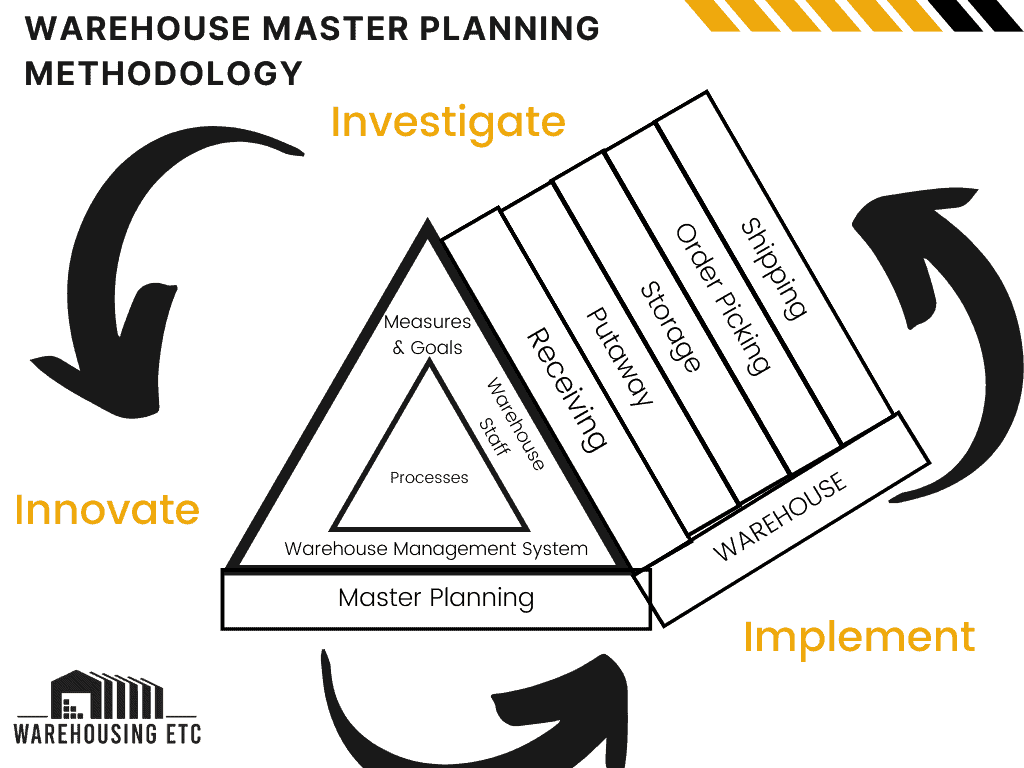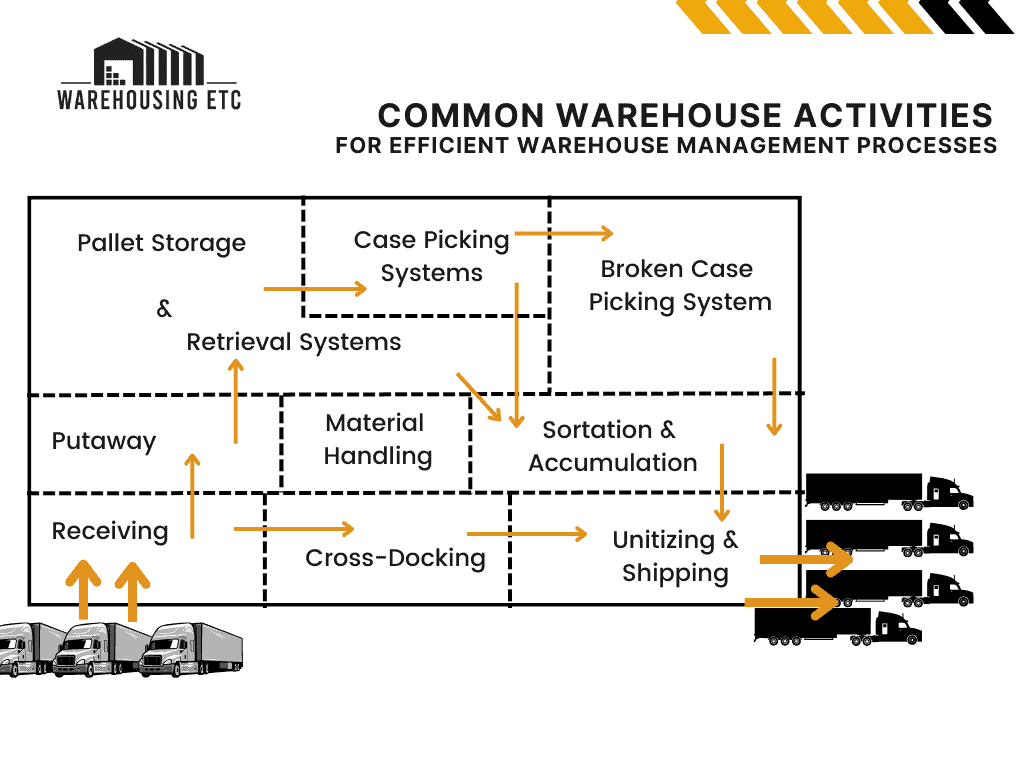In the ever-evolving landscape of global commerce, the efficiency and effectiveness of warehouse operations have become pivotal to business success. We offer a comprehensive guide into the intricate world of warehouse management. This guide is an indispensable resource for anyone looking to understand and improve the core aspects of their warehouse operations.
At the heart of thriving supply chains lie robust warehouse operations, a critical factor in meeting the increasing demands of customers and staying ahead in the competitive market. From small-scale businesses to multinational corporations, the principles of efficient warehouse management remain universal. In this guide, we will delve into the essential basics and explore best practices that can transform your warehouse operations into a model of efficiency and effectiveness.
By integrating the latest strategies, technologies, and methodologies in warehouse management, this guide aims to equip you with the knowledge and tools necessary to navigate the complexities of modern warehouse operations. Whether you’re looking to refine existing processes or build a foundation for new operations, this article serves as your roadmap to mastering world-class warehouse operation.
Table of Contents
Basics of Warehouse Operations
Embarking on the journey of mastering warehouse operations, we dive into its core essentials. Warehouse operations form the backbone of any supply chain. Getting these basics right sets the stage for efficiency, safety, and profitability.

Understanding Warehouse Operations
Firstly, let’s clarify what warehouse operations entail. Simply put, they encompass all activities involved in managing a warehouse. This includes inventory management, picking and packing, shipping and receiving, and maintaining equipment and facilities.
There are 8 core activities performed at most warehouses: Receiving, Prepackaging (optional), Putaway, Storage, Order Picking, Packing and/or Pricing (optional), Sortation and/or Accumulation, Unitizing & Shipping.
Here is a handful of topics used across the board for efficient warehouse operations.
Inventory Management
At the heart of warehouse operations lies inventory management. Effective management ensures that the right products are available in the right quantities at the right time. It involves tracking stock levels, forecasting demand, and minimizing overstock and understock situations.
Learn more about inventory management & control functions in warehouse operations.
Optimizing Layout and Space Utilization
Maximizing space utilization is critical. A well-organized warehouse maximizes storage space and enhances the efficiency of operations. This involves strategic placement of items based on demand, size, and weight, ensuring easy accessibility and efficient movement.
Safety and Compliance
Safety cannot be overstated. Ensuring a safe working environment for staff is paramount. This includes regular training, proper equipment handling, and adherence to safety protocols. Compliance with regulatory standards is also crucial to avoid legal issues and ensure smooth operations.
Technology Integration
In today’s world, integrating technology into warehouse operations is a game-changer. From automated inventory systems to advanced tracking methods, technology streamlines processes, reduces errors, and increases overall efficiency.
Efficient Picking and Packing
Picking and packing form the core of order fulfillment. Streamlining these processes ensures quick and accurate order processing, leading to customer satisfaction. Techniques like batch picking or zone picking can significantly enhance efficiency.
Shipping and Receiving
Efficient shipping and receiving procedures are the final steps in the warehouse operations chain. Timely and accurate handling of incoming and outgoing goods is essential to maintain inventory accuracy and customer satisfaction.
Continuous Improvement
Lastly, continuous improvement is the key to staying competitive. Regularly analyzing and improving processes, adopting new technologies, and training staff are essential to keep up with the evolving demands of warehouse operations.
In conclusion, mastering these basics of warehouse operations paves the way for a streamlined, efficient, and profitable warehouse. By focusing on these key areas, businesses can ensure they are well-equipped to handle the challenges of today’s dynamic market.
Challenges Managing Modern Warehouses

In the fast-paced world of modern warehousing, managers face a unique set of challenges. Based on insights from “World-Class Warehousing & Material Handling“, we delve into the core issues that shape today’s warehouse operations.
Handling Increased Transaction Volume
Modern warehouses are no longer just about large, bulk shipments. Today, they need to execute more transactions, often of smaller sizes. This shift demands heightened efficiency in handling a larger number of orders while maintaining accuracy and speed.
Managing Diverse Product Range
Warehouses now store a wider variety of products than ever before. This diversity necessitates more complex inventory management strategies to ensure the right products are stored, tracked, and retrieved efficiently.
Customization and Value-Added Services
Offering customization and additional services has become a norm. Warehouses must adapt to provide tailored solutions to customers, ranging from product customization to offering various value-added services. This shift requires a more flexible and responsive operational framework.
Reduced Order Processing Time
The pressure to process orders quickly is relentless. With less time to fulfill orders, warehouses must streamline their operations, employing smarter methods and technologies to keep up with the demand for rapid order processing.
Minimizing Errors in a High-Pressure Environment
In an environment where speed is crucial, the margin for error diminishes. Warehouses must strike a delicate balance between accelerating processes and maintaining accuracy, as even minor mistakes can have significant repercussions.
In summary, managing a modern warehouse involves navigating a labyrinth of complex challenges. From handling more transactions and diverse products to providing customization and ensuring speedy, error-free operations, today’s warehouse managers must be adept at multiple fronts. Embracing these challenges is key to achieving efficiency and excellence in warehouse operations.
Fundamentals of Warehouse Operations

The Warehouse Master Planning Methodology, as detailed in Figure 1-2 of “World-class Warehousing and Material Handling,” offers a comprehensive blueprint for optimizing warehouse operations. This methodology intricately weaves together various elements essential for a successful warehouse, from overarching strategies to specific processes.
Master Planning: The Strategic Foundation
Master planning stands at the apex of warehouse operations. It’s a strategic endeavor, where the overarching goals and objectives for the warehouse are defined. This includes determining the size, location, design, and overall layout of the warehouse, ensuring it aligns with the business’s long-term goals.
Warehouse: Designing for Efficiency
The physical warehouse itself is a crucial element. Here, the focus is on designing a space that maximizes efficiency and productivity. This involves thoughtful layout planning, optimal use of storage systems, and ensuring smooth flow paths for goods and staff.
Warehouse Management System (WMS): The Technological Core
A Warehouse Management System (WMS) is the technological backbone. It streamlines operations, from tracking inventory to automating various processes. An effective WMS enhances accuracy, reduces manual labor, and provides valuable data analytics, driving informed decision-making.
Warehouse Staff: The Human Element
The human element, the warehouse staff, is pivotal. Their skills, training, and motivation directly impact the warehouse’s efficiency. Investing in proper training, fostering a positive work environment, and ensuring clear communication are key to maintaining a high-performing team.
Measures and Goals: Setting Benchmarks
Setting clear measures and goals is vital for continuous improvement. This includes establishing key performance indicators (KPIs) for various aspects of warehouse operations, enabling the monitoring and measuring of performance against set benchmarks.
Processes: The Operational Backbone
The methodology emphasizes the importance of streamlined processes in warehouse operations. These include:
- Receiving: The initial stage where goods are received, verified, and prepared for storage.
- Putaway: The process of moving goods to their designated storage location.
- Storage: Efficiently storing goods in a way that balances accessibility and optimal use of space.
- Order Picking: The critical task of gathering products from their storage locations to fulfill customer orders.
- Shipping: The final stage, where orders are packed, labeled, and dispatched.
Each process requires specific strategies and tools to ensure efficiency and accuracy.
The Warehouse Master Planning Methodology provides a structured and comprehensive approach to warehouse operations. By understanding and implementing each component of this methodology, warehouse managers can build a robust, efficient, and adaptable operation. This foundational knowledge is essential for diving into the specifics of each warehouse activity, ensuring a well-rounded and effective approach to warehouse management.
Inventory Management & Inventory Control Functions
Inventory management and control are the lifeblood of effective warehouse operations. They encompass the methods and processes used to manage the flow of goods within a warehouse and ensure the availability of items for order fulfillment. This section delves into the key functions and practices that constitute robust inventory management and control in modern warehousing.
Essentials of Inventory Management
Inventory management involves overseeing the stock levels of goods, from the point of purchase to the point of sale. It includes:
Stock Monitoring: Keeping track of inventory levels to prevent overstocking or stock shortages.
Demand Forecasting: Using historical data and market trends to predict future product demands, ensuring adequate stock levels.
Order Management: Efficiently processing and fulfilling customer orders, which includes managing back-orders and special orders.
Supplier Management: Maintaining strong relationships with suppliers to ensure timely replenishment of inventory.

Effective inventory management aims to maintain optimal stock levels, minimizing holding costs while maximizing the ability to meet customer demands promptly.
Core Functions of Inventory Control
Inventory control, on the other hand, focuses more narrowly on the internal processes that manage inventory:
- Quality Control: Regular inspection of inventory for quality assurance, ensuring goods are in sellable condition.
- Stock Audits and Cycle Counts: Periodic checks of inventory to ensure record accuracy, identifying discrepancies between physical stock and inventory records.
- Loss Prevention: Implementing measures to reduce inventory shrinkage due to theft, damage, or administrative errors.
- Inventory Classification: Categorizing inventory based on various criteria (e.g., value, turnover rate) to prioritize management efforts.
Integrating Technology for Enhanced Management and Control
Incorporating technology, such as Warehouse Management Systems (WMS), barcoding, and RFID systems, can significantly enhance inventory management and control. These technologies provide real-time data, improve tracking accuracy, and facilitate automated replenishment systems, streamlining the entire inventory process.
Conclusion: Inventory Operations for Efficiency
In essence, inventory management and control are pivotal in maintaining the efficiency and effectiveness of warehouse operations. A well-orchestrated approach to inventory ensures that the right products are available at the right time and in the right condition, directly impacting customer satisfaction and operational cost-efficiency. By mastering these functions, warehouses can significantly enhance their operational capability and business resilience.
Warehouse Operations Best Practices

In the realm of warehouse operations, efficiency and innovation are not just goals; they are necessities for success. This guide, inspired by “World-Class Warehousing and Material Handling”, particularly Figure 1-4, is tailored for warehouse owners and decision-makers, focusing on elevating the common warehouse activities to world-class standards. These activities include Receiving, Putaway, Pallet Storage & Retrieval Systems, Material Handling, Case Picking Systems, Broken Case Picking Systems, Sortation & Accumulation, Cross-Docking, and Unitizing & Shipping.
Optimizing Core Activities for Maximum Efficiency
Each activity, from the initial receiving of goods to the final unitizing and shipping, forms a critical part of the warehouse operations puzzle. The key is to optimize these activities, not in isolation, but as interconnected processes that contribute to the overall efficiency and productivity of the warehouse. This involves employing advanced systems, strategic planning, and continuous process improvement.

Adopting a Strategic Approach
Decision-makers in the warehouse industry face the challenge of balancing cost, speed, and accuracy. This guide offers insights on adopting a strategic approach to warehouse operations, ensuring that each activity is not only efficient but also aligns with broader business objectives.
Let’s dive deeper into each of these critical warehouse activities.
1. Receiving at the Heart of Warehouse Operations
Receiving is a critical first step in warehouse operations, setting the stage for all subsequent activities. For warehouse owners and decision-makers, mastering this stage is crucial for overall efficiency. This section incorporates principles from “World-class Warehousing and Material Handling” and modern training insights, focusing on strategies like direct shipping, cross-docking, and effective scheduling.
If goods are not properly received, it will be very difficult to handle it properly for putaway, storage, pick & ship.
Direct Shipping: Efficiency Beyond Traditional Receiving
Direct shipping eliminates the need for warehousing certain products, streamlining the supply chain. This method can streamline supply chain lead times and remove work from your internal warehouse.
For instance, a manufacturer of electronics might use direct shipping for high-demand items during peak sales periods, sending products directly from the manufacturing plant to retail outlets or customers, thereby reducing warehouse load and speeding up delivery.
Cross-Docking: A Real-Time Approach to Receiving
Cross-docking minimizes warehousing time by transferring incoming goods directly to outbound trucks. When cross-docking freight, inbound truckloads are scheduled for delivery into the warehouse for vendors. When received, the freight is immediately sorted for outbound orders and transported to the docks where outbound trucks are waiting. No products are stored in the warehouse in this flow of goods.
A notable example is a large retail chain that uses cross-docking to quickly distribute products to various stores. Goods arriving from suppliers are immediately sorted and reloaded onto trucks destined for specific stores, reducing storage costs and ensuring fresh inventory.
Effective Receiving Scheduling: The Art of Timing
A well-orchestrated receiving schedule can prevent congestion and delays. For instance, a distribution center might schedule receiving of non-perishable goods during off-peak hours while prioritizing perishables during the start of the workday to ensure immediate processing. This approach balances the workload and maintains the flow of goods.
It is often necessary to create a synchronized daily, or hourly schedule to ensure all resources are used most effectively such as, dock doors, fork lifts and equipment, personnel, and staging space.
Receiving Conclusion
Enhancing the receiving process in warehouse operations requires a blend of strategic approaches and practical execution. Direct shipping, cross-docking, effective scheduling, and pre-receiving preparations are pivotal for operational efficiency. By learning from real-world applications of these strategies, warehouse owners and decision-makers can significantly enhance their operational capacity and adapt to the dynamic demands of the market.
2. Prepackaging (optional)
The most time we ever have available to prepare a product for shipment is at the moment it is received. At the time of the demand there is no time to handle and prepare the goods, so it can be effective to Prepackage product at time of receiving.
Principles of Pre-Receiving and Receipt Preparation
Pre-receiving involves activities like allocating storage space and preparing handling equipment. A real-world example is a warehouse that, prior to a large shipment, allocates specific docking bays and prepares the required equipment and personnel for unloading. This preparation expedites the unloading process and ensures a smooth flow into storage or picking areas.
Pre-receiving activities helps streamline the time taken to receive goods, which often is very time consuming. If product information for Inbound loads is capture ahead of time, the warehouse can do prep-work before the load arrives. They may be able to create the load in the system, assign identifiers and create all product identification from the vendors email communications and paperwork.
When goods require extra handling before shipping to customers, receipt preparation may be a good fit. Receipt preparation is when we prepare goods for outbound shipment immediately when the warehouse receives the goods. This could include prepacking units into different quantity case packs, adding labels and other steps that consume time when picking & shipping freight.
Common Scenarios with Prepackaging
There are countless use cases in the warehouse for goods that may require extra handling and processing.
Here are a few common preparation activities that can be done at the time of receiving:
- Prepack goods into sellable quantities. For outbound orders, it is fastest to pick sellable volumes of goods such as single units, case packs, half pallets, or full pallets.
- Apply labels and tags. Now is the time to apply extra labels like Amazon FNSKUs or other tags required internally or by resale channels.
- Cubing and weighing freight for storage and transportation. Collect all the product information you and your Team will need to most effectively store and ship the goods. Use electronics and automation to speed up this process.
3. Putaway
The putaway process is a crucial component of warehouse operations, directly impacting efficiency and order fulfillment accuracy.
At the core, putaway is order picking in reverse. Most of the principles that streamline picking processes also work great for putaway.
Direct Putaway: Streamlining Storage
Direct putaway involves moving goods directly to their final storage location, whether primary or reserve. Primary locations are typically more accessible areas used for high-demand items, while reserve locations are used for less frequently accessed stock. An example is a retail warehouse where seasonal goods are directly put away into reserve locations to free up primary space for current high-demand products.
Directed Putaway: Guided Efficiency
In directed putaway, a Warehouse Management System (WMS) directs operators on where and how to place goods in storage. This method ensures optimal space utilization and reduces handling time. For instance, a distribution center might use WMS-directed putaway to systematically fill racks based on product size, weight, and demand, enhancing overall storage efficiency.
Batched and Sequenced Putaway: Organized Approach
Batching and sequencing putaway involve sorting inbound materials for efficient storage. This method is particularly effective in large warehouses with a diverse range of products. For example, a food distribution warehouse might batch and sequence putaway based on product type and expiration dates, ensuring quick access to items with closer expiration for immediate dispatch.
Interleaving: Maximizing Task Efficiency
Interleaving combines putaway and retrieval tasks to maximize efficiency. When a forklift is returning from a delivery, it can immediately pick up goods for putaway, reducing empty travel time. A practical example is in a manufacturing warehouse, where forklifts tasked with moving finished goods to storage areas can simultaneously retrieve raw materials for production lines.
Putaway Conclusion
Mastering the putaway process is essential for optimizing warehouse operations. By implementing strategies like direct putaway, directed putaway, batched and sequenced putaway, and interleaving, you can significantly enhance operational efficiency, space utilization, and overall productivity. These strategies form the backbone of a streamlined, world-class warehouse operation, directly contributing to business success.
4. Pallet Storage & Retrieval Systems in Warehouse Operations
Pallet storage systems are a foundational element in warehouse operations, aimed at maximizing storage density and efficiency. The selection of these systems is driven by the need to accommodate on-hand inventory and manage turnover items effectively. Various types of pallet storage systems include:
Block Stacking: This is a cost-effective solution where pallets are stacked directly on the floor. With this approach, not racking is required. It’s ideal for warehouses with a large volume of the same product and is commonly seen in wholesale bulk storage. Product can be stored very densely.
Stacking Frames: These are used to safely stack pallets vertically and are beneficial in managing diverse products without the need for shelving.
Single-Deep Selective Pallet Rack: Offering high selectivity, this system allows easy access to every pallet but requires more floor space.
Double-Deep Rack: This is a denser storage solution where pallets are stored two deep, reducing aisle space but also accessibility.
Drive-In Rack: Designed for high-density storage, drive-in racks allow forklifts to drive directly into the rack’s bays for pallet placement.
Drive-Thru Rack: Similar to drive-in racks but with access from both ends, allowing a first-in-first-out (FIFO) storage strategy.
Pallet Retrieval Systems
Retrieval system selection focuses on balancing high handling productivity with capital investment (CapEx). Various types of retrieval systems include:
Walkie Stackers, Counterbalance Lift Trucks: These are versatile for various tasks but require sufficient aisle width.
Straddle Trucks, Straddle Reach Trucks: Ideal for tighter spaces and can lift pallets to greater heights.
Sideloaders, Turret Trucks: These are effective in very narrow aisles, maximizing storage space.
Hybrid Trucks: Combining features of different trucks for versatile use.
Automated Storage and Retrieval (ASR) Machines: These are high-capacity systems, perfect for high-throughput environments, reducing manual labor and increasing accuracy.


Selecting the right pallet storage and retrieval systems is crucial for maximizing warehouse efficiency. Warehouse owners and decision-makers must consider factors like inventory type, turnover rate, space availability, and CapEx when choosing these systems. Implementing the appropriate solutions can lead to significant improvements in storage density, handling productivity, and overall operational efficiency in warehouse operations.
5. Order Picking
Order picking, the process of retrieving products from storage to fulfill customer orders, is a crucial aspect of warehouse operations. Optimizing this process involves understanding and implementing efficient picking systems suitable for different types of products and warehouse layouts.
Case Picking Systems
- Pick Face Palletizing Systems: Involves organizing pallets at the picking face for easy access, ideal for high-volume, uniform products. Common in large distribution centers where speed and volume are paramount, like in major retail warehouses.
- Downstream Palletizing: Focuses on consolidating picked items downstream for palletization, optimizing space and labor. Often used in e-commerce fulfillment centers where diverse products are consolidated after picking.
- Direct Loading Systems: Streamlines the process by directly loading picked items onto delivery trucks, reducing handling. Ideal for industries where time-sensitive delivery is crucial, such as food distribution.
- Selection of Case Picking Systems: Involves choosing the right system based on product characteristics, warehouse design, and operational requirements.
Small Item Picking Systems
- Picker-to-Stock Systems: Pickers travel to stock locations to retrieve items, suitable for warehouses with a wide variety of small items. Widely used in smaller warehouses or ones with a high variety of products.
- Stock-to-Picker Systems: Items are brought to a central picking location, often automated, enhancing picking efficiency. Common in modern warehouses with high automation levels, such as pharmaceutical distribution.
- Automated Item Dispensing Machines: Used for rapid and accurate picking of small, individual items. Utilized in sectors requiring high precision and speed, like electronics parts distribution.
- Comparison and Selection: Evaluating and choosing the best system based on factors like order volume, item size, and warehouse layout.
Order Picking Operations
- Issue Pack Optimization: Streamlining the packaging process to reduce material usage and costs. In warehouse operations, this can be crucial to reduce waste and costs.
- Pick from Storage: Efficiently retrieving items directly from storage areas. Efficiency in this area can significantly impact sectors with large product catalogs.
- Pick Task Simplification: Implementing strategies to simplify picking tasks, thereby enhancing speed and accuracy.
- Order Batching: Grouping orders to minimize travel time and increase picking efficiency.
- Mutoh: A technique involving multi-order picking to optimize efficiency.
- Slotting Optimization: Strategically placing items in the warehouse to minimize picking time.
- Pick Sequencing: Organizing the order of item picking to streamline operations.
Conclusion for Order Picking
For warehouse operations, optimizing order picking involves a holistic approach that includes selecting appropriate systems, streamlining processes, and continuously adapting to changing demands. Implementing these practices can lead to significant improvements in efficiency, accuracy, and customer satisfaction.
6. Packing and/or Pricing (optional)
After order picking, packing and pricing are vital processes in warehouse operations. These steps not only ensure product safety during transit but also reflect accuracy in order fulfillment and customer billing.
Packing: Ensuring Product Safety and Efficiency
- Material Selection: Choosing the right packing materials for product safety and cost-effectiveness.
- Automated Packing Systems: Utilized in high-volume warehouses to increase speed and consistency.
- Custom Packing Solutions: Employed for fragile or irregularly shaped items, ensuring safe delivery.
Pricing: Accuracy and Compliance
- Automated Pricing Systems: Often integrated with warehouse management systems for real-time pricing updates.
- Compliance with Pricing Regulations: Ensuring adherence to legal standards and customer agreements.
Integrating Packing and Pricing with Picking and Sortation
Efficiently linking these processes with picking and sortation is crucial. For example, in an e-commerce warehouse, automated systems can streamline the transition from picking to packing and pricing, reducing errors and improving throughput.
Packing and pricing are more than just final touches; they’re integral components of the warehouse process flow, adding value to the overall efficiency and customer satisfaction. By optimizing these steps, warehouses can enhance the reliability and accuracy of their operations.
7. Sortation and/or Accumulation
Dive into Sortation Strategies
Sortation is a dynamic process that requires careful planning and execution. It’s essential to consider:
- System Customization: Adapting sortation systems to meet the specific needs of different products, from fragile items to high-volume goods. Utilizing technology like automated conveyors and sorters tailored for specific item profiles.
- Efficient Layout Planning: Designing the sortation area to minimize congestion and maximize flow efficiency. This could involve strategic placement of sortation bins and optimization of conveyor paths.
Effective Accumulation Techniques
Proper accumulation is key to handling peak loads and ensuring a steady supply to shipping areas:
- Adaptive Buffering Solutions: Implementing smart buffering systems that can adjust to varying operational needs. This includes using modular storage solutions that can be scaled up or down based on current demand.
- Technology Integration: Employing sensors and real-time tracking to monitor and manage buffer zones, ensuring they are used effectively and not becoming bottlenecks.
Practical Examples and Best Practices
In a high-volume retail distribution center, integrating advanced sortation systems with real-time tracking can drastically improve sorting accuracy and speed, directly impacting order fulfillment times.
For a warehouse dealing with a mix of bulk and individual items, flexible accumulation zones can be critical. Using adjustable shelving and modular storage units can accommodate different product types and sizes, ensuring smooth flow.
Incorporating advanced, customized sortation and adaptive accumulation strategies can significantly elevate warehouse operations. These processes, when optimized, not only improve efficiency but also contribute to better inventory management and customer satisfaction. Tailoring these systems to the specific needs and dynamics of your warehouse operations is crucial for achieving operational excellence.
8. Unitizing & Shipping
Unitizing and shipping are the final, critical steps in warehouse operations, ensuring products are securely packaged and efficiently dispatched. These processes, when optimized, can significantly enhance customer satisfaction and operational efficiency.
Container Optimization
- Efficient Use of Space: Maximizing container space while ensuring safe transport. Techniques include using optimal box sizes and strategically packing items to minimize empty space.
- Cost-Efficiency: Balancing space utilization with shipping costs, especially for air freight where space is at a premium.
Container Loading and Void Fill
- Loading Techniques: Effective loading patterns to maximize space and minimize damage during transit.
- Void Fill Solutions: Using materials like air pillows or foam to prevent item movement, essential for fragile goods.
Weigh Checking for Compliance
- Accuracy in Shipping: Ensuring shipments meet weight regulations to avoid penalties and ensure safety.
- Integration with WMS: Automated systems for real-time weight monitoring and compliance checks.
Automated and Direct Loading Processes
- Speed and Efficiency: Automated loading systems reduce manual labor and expedite the shipping process.
- Real-World Example: In e-commerce fulfillment centers, automated loading can significantly speed up dispatch times.
Effective Dock Management
- Streamlining Dock Operations: Scheduling and managing dock activities to minimize wait times and maximize throughput.
- Technology Integration: Using dock scheduling software for better time and resource management.
Unitizing and shipping are vital for ensuring that the efforts invested in earlier warehouse processes culminate in successful order fulfillment. By optimizing these steps, warehouse operations can achieve greater efficiency, accuracy, and customer satisfaction.
Warehouse Layouts for Operational Efficiency
A well-planned warehouse layout is fundamental to operational efficiency. It involves strategic placement of resources and processes to streamline operations, enhance productivity, and ensure safety.
Space Requirements Planning
- Assessing Space Needs: Determine the total space needed for various warehouse processes. This involves considering inventory size, handling equipment, and movement areas.
- Real-World Example: A large e-commerce warehouse may allocate significant space for fast-moving products near packing and shipping areas to speed up order fulfillment.
Material Flow Planning
- Designing the Flow: Choose between a U-shaped, straight-through, or modular flow design based on operational needs.
- Efficiency in Movement: Streamline the movement of goods to minimize handling and reduce bottlenecks.
Adjacency Planning
- Strategic Function Placement: Position functions with high interdependency close to each other to enhance efficiency.
- Example: Placing the receiving area near quality control and storage for quicker processing of incoming goods.
Process Location and High-Bay Space Utilization
- Assigning Processes: Allocate processes with high storage needs to areas with high-bay storage to maximize vertical space.
- Optimizing High-Bay Space: Use automated storage and retrieval systems (AS/RS) for effective use of high-bay areas.
Expansion and Contraction Planning
- Flexible Design: Develop strategies for expanding or contracting each process area to accommodate changing business needs.
- Adaptability: Include modular structures or movable shelving systems to quickly adjust to demand fluctuations.
An efficient warehouse layout is crucial for smooth operations. It requires thoughtful planning of space, material flow, adjacency, and flexibility to adapt to business growth and market changes. By optimizing the warehouse layout, owners and decision-makers can significantly enhance operational efficiency and productivity.
Warehouse Operations Summary
In this comprehensive guide, we’ve navigated through the essentials and complexities of warehouse operations.
Key takeaways include the importance of efficient systems for inventory management, picking, packing, and shipping, alongside the need for technological innovation and adaptability. For warehouse owners and decision-makers, success lies in tailoring these best practices to their unique operational needs while embracing continuous improvement. As the warehousing landscape evolves, staying informed and adaptable is crucial.
This guide is your blueprint for building a world-class warehouse, prepared for the challenges and opportunities of the dynamic global market.










